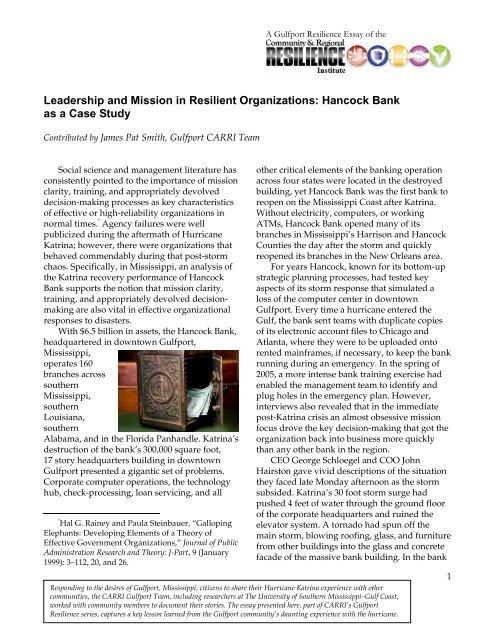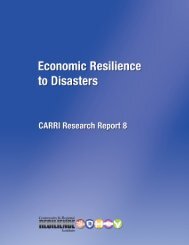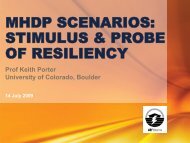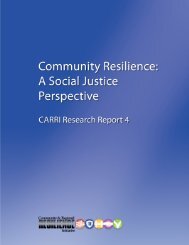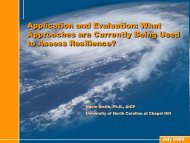Hancock Bank - Community & Regional Resilience Institute
Hancock Bank - Community & Regional Resilience Institute
Hancock Bank - Community & Regional Resilience Institute
You also want an ePaper? Increase the reach of your titles
YUMPU automatically turns print PDFs into web optimized ePapers that Google loves.
A Gulfport <strong>Resilience</strong> Essay of the<br />
Leadership and Mission in Resilient Organizations: <strong>Hancock</strong> <strong>Bank</strong><br />
as a Case Study<br />
Contributed by James Pat Smith, Gulfport CARRI Team<br />
Social science and management literature has<br />
consistently pointed to the importance of mission<br />
clarity, training, and appropriately devolved<br />
decision-making processes as key characteristics<br />
of effective or high-reliability organizations in<br />
normal times. * Agency failures were well<br />
publicized during the aftermath of Hurricane<br />
Katrina; however, there were organizations that<br />
behaved commendably during that post-storm<br />
chaos. Specifically, in Mississippi, an analysis of<br />
the Katrina recovery performance of <strong>Hancock</strong><br />
<strong>Bank</strong> supports the notion that mission clarity,<br />
training, and appropriately devolved decisionmaking<br />
are also vital in effective organizational<br />
responses to disasters.<br />
With $6.5 billion in assets, the <strong>Hancock</strong> <strong>Bank</strong>,<br />
headquartered in downtown Gulfport,<br />
Mississippi,<br />
operates 160<br />
branches across<br />
southern<br />
Mississippi,<br />
southern<br />
Louisiana,<br />
southern<br />
Alabama, and in the Florida Panhandle. Katrina’s<br />
destruction of the bank’s 300,000 square foot,<br />
17 story headquarters building in downtown<br />
Gulfport presented a gigantic set of problems.<br />
Corporate computer operations, the technology<br />
hub, check-processing, loan servicing, and all<br />
*<br />
Hal G. Rainey and Paula Steinbauer, “Galloping<br />
Elephants: Developing Elements of a Theory of<br />
Effective Government Organizations,” Journal of Public<br />
Administration Research and Theory: J-Part, 9 (January<br />
1999): 3–112, 20, and 26.<br />
other critical elements of the banking operation<br />
across four states were located in the destroyed<br />
building, yet <strong>Hancock</strong> <strong>Bank</strong> was the first bank to<br />
reopen on the Mississippi Coast after Katrina.<br />
Without electricity, computers, or working<br />
ATMs, <strong>Hancock</strong> <strong>Bank</strong> opened many of its<br />
branches in Mississippi’s Harrison and <strong>Hancock</strong><br />
Counties the day after the storm and quickly<br />
reopened its branches in the New Orleans area.<br />
For years <strong>Hancock</strong>, known for its bottom-up<br />
strategic planning processes, had tested key<br />
aspects of its storm response that simulated a<br />
loss of the computer center in downtown<br />
Gulfport. Every time a hurricane entered the<br />
Gulf, the bank sent teams with duplicate copies<br />
of its electronic account files to Chicago and<br />
Atlanta, where they were to be uploaded onto<br />
rented mainframes, if necessary, to keep the bank<br />
running during an emergency. In the spring of<br />
2005, a more intense bank training exercise had<br />
enabled the management team to identify and<br />
plug holes in the emergency plan. However,<br />
interviews also revealed that in the immediate<br />
post-Katrina crisis an almost obsessive mission<br />
focus drove the key decision-making that got the<br />
organization back into business more quickly<br />
than any other bank in the region.<br />
CEO George Schloegel and COO John<br />
Hairston gave vivid descriptions of the situation<br />
they faced late Monday afternoon as the storm<br />
subsided. Katrina’s 30 foot storm surge had<br />
pushed 4 feet of water through the ground floor<br />
of the corporate headquarters and ruined the<br />
elevator system. A tornado had spun off the<br />
main storm, blowing roofing, glass, and furniture<br />
from other buildings into the glass and concrete<br />
facade of the massive bank building. In the bank<br />
Responding to the desires of Gulfport, Mississippi, citizens to share their Hurricane Katrina experience with other<br />
communities, the CARRI Gulfport Team, including researchers at The University of Southern Mississippi–Gulf Coast,<br />
worked with community members to document their stories. The essay presented here, part of CARRI’s Gulfport<br />
<strong>Resilience</strong> series, captures a key lesson learned from the Gulfport community’s daunting experience with the hurricane.<br />
1
Leadership and Mission in Resilient Organizations: <strong>Hancock</strong> <strong>Bank</strong> as a Case Study<br />
headquarters alone, 1,300 windowpanes were<br />
shattered, opening the interior to a spray of salty<br />
wind-driven water all the way up the 17 story<br />
tower. On top, the bank’s own inch-thick steel<br />
roof had been peeled back and blown off,<br />
opening the entire 17 floors to massive flooding<br />
down the elevator shafts and any hollowed<br />
columns of shafts between floors. Interior walls<br />
were so water logged all the way to the top of the<br />
building that the slightest pressure would send<br />
sheet rock crashing down elevator shafts or onto<br />
concrete floors. In the 5th floor data center on the<br />
north side of the building, wind had blasted out<br />
the east wall. The damages totaled $84 million.<br />
With a 40 mile per hour wind still blowing,<br />
COO John Hairston managed to get a cell phone<br />
call through to his Chicago team who had flown<br />
out with back-up<br />
computer data 48 hours<br />
earlier. The message to<br />
Chicago team leader Jeff<br />
Andrews was simple.<br />
“Jeff, the building’s a total<br />
loss,” Hairston said.<br />
“You’ve got to move the<br />
flag. Bring up the data<br />
center in Chicago.” On the<br />
other end of the line, even<br />
though the routine had<br />
been tested many times before, Jeff Andrews<br />
could not believe what he was hearing. “It can’t<br />
be—<strong>Hancock</strong> Plaza cannot be damaged that<br />
badly,” he implored. Having just climbed<br />
15 flights of stairs and a two story exterior ladder<br />
on the Gulfport building, Hairston stated<br />
emphatically, “That’s what I said, Jeff. Trust me.<br />
Move the flag. We won’t be in this building for a<br />
long time . . . . What is important right now is . . .<br />
to bring those systems up in Chicago.” Sitting in<br />
Chicago and still stunned, Andrews protested,<br />
“You know, we’ve never done this before.” At<br />
this point, Hairston interjected by saying what<br />
was to become a theme for this organization.<br />
“We’ve tested it every year, and it’s worked<br />
every year. I believe in you. I believe in the team.<br />
You all will get it done.”<br />
With the wind still blowing, Hairston said the<br />
words that amounted to huge devolution of<br />
authority to the Chicago team. “You’ve got<br />
4 days. Bring it up, get it current. I may not be<br />
able to talk to you again for a while. You<br />
remember, you bring it up . . . . stay the course.<br />
Your job is to get those systems up. If we cannot<br />
get the systems up, we don’t have a company.<br />
Get them up.” With a clear mission, drawing on<br />
good training, and with little to no<br />
communications from the Gulfport headquarters,<br />
<strong>Hancock</strong> <strong>Bank</strong>’s skeleton-force i-tech team<br />
worked that emergency plan and got alternate<br />
technology operations up in 3 days.<br />
The bank’s scripted emergency plan also<br />
called for opening branches with available<br />
employees and facilities as rapidly as possible.<br />
<strong>Hancock</strong> wanted to be the last bank closed before<br />
a hurricane and the first to reopen. However, the<br />
morning after the storm, the stunning extent of<br />
the bank’s losses raised questions about this goal.<br />
Huddled over the hood of a car on that Tuesday<br />
morning, key executives confronted the meaning<br />
of the lack of electricity, computers, and normal<br />
police and fire protection for basic banking. If<br />
you reopened, how would you know who your<br />
customers were? What about storm victims who<br />
presented themselves asking for cash but who<br />
had lost everything, including checkbooks,<br />
wallets, and identification. How would you<br />
check their balances to guard against overdrafts<br />
or fraud?<br />
What about<br />
people who<br />
would need<br />
cash but who<br />
banked at<br />
other<br />
institutions?<br />
The risk was<br />
clear. Credit cards would not work for gas, food,<br />
or any other basic need, and it was August 30,<br />
payday. People would need cash.<br />
In that moment of worried consideration, the<br />
bank’s executives went back to the bank charter<br />
and asked basic questions about institutional<br />
values and mission. They noted that there was no<br />
mention of the word “profit” in the bank’s 1899<br />
charter. The old charter gave the bank the<br />
mandate to serve people and take care of<br />
2
Leadership and Mission in Resilient Organizations: <strong>Hancock</strong> <strong>Bank</strong> as a Case Study<br />
communities. They served by keeping money<br />
safe and making money available. What about<br />
risk? Over the years, the 80 year old chairman,<br />
Leo Seal Jr., had drilled into their heads the<br />
concept that banking would be an impossible<br />
business unless 99 percent of the people were<br />
honest. With this core belief in mind, bank<br />
officials made the tough decision to stick with the<br />
charter and serve the community by providing<br />
money—even, or especially, in a crisis where<br />
security was not guaranteed. In a gutsy move,<br />
bank officers decided to allow people—whether<br />
they be <strong>Hancock</strong> customers or not—to draw up<br />
to $200 cash if they could simply write out their<br />
name, address, and social security number on a<br />
scrap of paper.<br />
On that Tuesday after the storm, ten branches<br />
of the <strong>Hancock</strong> <strong>Bank</strong> opened without power in<br />
the disaster zone. Three days later, 30 of the<br />
company’s 50 offline branches were opened<br />
without<br />
lights,<br />
phones, and<br />
in some cases<br />
without roofs<br />
or buildings.<br />
In Pass<br />
Christian and<br />
Waveland,<br />
Mississippi, they opened with card tables under<br />
tarps or outside repossessed mobile homes.<br />
<strong>Bank</strong>ing was reduced to post-it-note IOUs that<br />
were tossed into boxes to be processed later.<br />
Because of this decision, tens of millions of<br />
dollars flowed into the community, much of it<br />
literally washed, dried, and ironed after being<br />
salvaged from waterlogged casinos, bank vaults<br />
and ATMs.<br />
<strong>Hancock</strong>’s mission-driven response put more<br />
than $42 million in cash into the community in<br />
that week after the storm—cash supplied<br />
whether or not the person normally banked with<br />
<strong>Hancock</strong>. The decision made by <strong>Hancock</strong>’s<br />
executives might have led to massive losses. In<br />
fact, at least $3.5 million went out the door to<br />
people who could not later be linked to any<br />
account or working phone. Three years later,<br />
CEO George Schloegel reported of that of the<br />
millions of dollars given to people for a name<br />
and address on a post-it note, all but $200<br />
thousand had come back to the bank. As people<br />
returned to the area and got on their feet, the<br />
majority remembered that <strong>Hancock</strong> <strong>Bank</strong> IOU<br />
and paid it back. Moreover, in the 5 months<br />
following the storm, <strong>Hancock</strong> <strong>Bank</strong> opened<br />
13,000 new accounts. According to Schloegel,<br />
many people said, “You were there when I<br />
needed you. You’re going to be my bank.”<br />
Overall deposits grew by $1.5 billion. Ultimately,<br />
the clarity of mission and leadership exercised by<br />
<strong>Hancock</strong> <strong>Bank</strong> during Katrina provides<br />
immensely valuable guidance for organizations<br />
looking to become more resilient for future and<br />
inevitable disasters and chaotic disruptions.<br />
Some of the information contained in this article<br />
was provided to the author during interviews with<br />
John Hairston and George Schloegel (University of<br />
Southern Mississippi, Katrina Oral History<br />
Collection, McCain Archives, Hattiesburg,<br />
Mississippi) and Sidney Rushing.<br />
3


